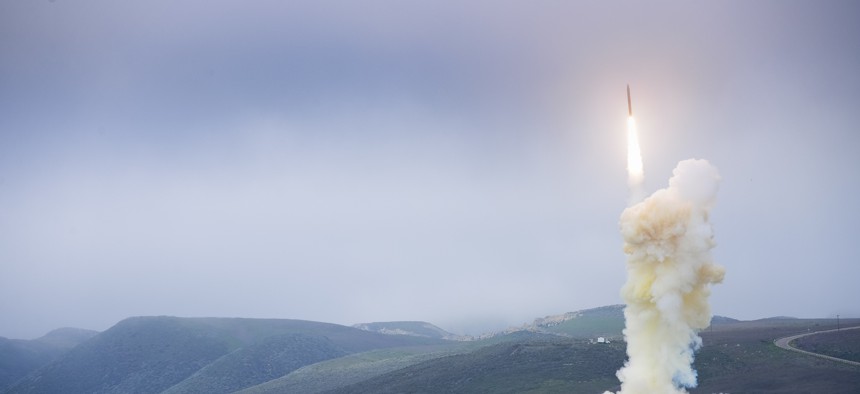
The Missile Defense Agency successfully conducted a flight test of a three-stage Ground-Based Interceptor from Vandenberg Air Force Base, Calif. MDA
Pick Up the Pace on Missile Defense
Five steps to keep U.S. defenses ahead of North Korea’s efforts to make weapons that can threaten American cities.
Last month, as Japanese Prime Minister Abe and President Trump met to forge a deeper alliance between our two countries, North Korea launched a mobile solid-fueled ballistic missile into the Sea of Japan, a missile similar to one previously launched from a submersible barge. The message it sends to the world is clear: Kim Jong-un is continuing his pursuit of sophisticated, long-range delivery systems capable of reaching the United States and our closest allies.
Kim Jong-un’s publicly stated goal is to develop a nuclear-capable intercontinental ballistic missile that can strike the continental United States. To be clear, the man who starves his own citizens, sentences them to inhumane “labor camps,” and who – just last month – allegedly had his half-brother assassinated in Malaysia, is the same person who wants to hold hostage American cities such as New York, Los Angeles, and Chicago. Top military and intelligence officials have publicly said that it is no longer a matter of if Kim Jong-un gets this capability, but rather when. Congress and the administration must act to protect the American people by picking up the pace on missile defense.
Unfortunately, our commitment to funding homeland missile defense has been inconsistent. Early in his presidency, President Obama fulfilled his campaign promise to “cut investments in unproven missile defense systems” by slashing billions of dollars over three years. Then came an additional nuclear detonation and other “irresponsible and reckless provocations” from an unstable North Korea. In March 2013, the administration made a U-turn, moving to increase our deployed missile defense capacity by 50 percent citing “irresponsible and reckless provocations” from North Korea.
Four years later, we stand at another inflection point. Sanctions and negotiations have not curbed Pyongyang’s nuclear and ballistic missile ambitions. Since 2013, Kim Jong-un has detonated three nuclear weapons and tested more than 60 missiles – more than twice as many nuclear weapons and missile tests as his father and grandfather combined. And he continues to abuse, exploit, and impoverish his own people, mortgaging their well-being for his unholy crusade for a miniaturized nuclear warhead and the missiles to deliver it to Guam, Alaska, and the contiguous United States. The Obama administration’s policy of strategic patience with North Korea has failed.
Thankfully, the United States enjoys a measure of protection against a limited missile attack from North Korea. By the end of this year, we will have 44 ground-based interceptors in Alaska and California, and by 2019, we will have a new radar and other means to allow our warfighters to better track and discriminate threats. Moreover, Congress continues its bipartisan efforts to modernize homeland missile defense and to mandate yearly testing of the system.
Still, North Korea’s missile development threatens to outpace U.S. defenses in the long-term. To face down this challenge, the Trump administration – as part of implementing the Jan. 27 Presidential Memorandum on Rebuilding the U.S. Armed Forces – should consider at least five avenues to strengthen our missile defense.
First, the administration should continue efforts to complete a more reliable and lethal kill vehicle, the “bullet” that intercepts the incoming warhead in space. Designed to bring down long-range missiles, this new kill vehicle will also be cheaper and easier to produce — two qualities that will help ensure our defenses continue to outpace the growing threat.
See also Calm Down About North Korea’s Nukes
And Washington’s Dangerous Drums of War on North Korea
Second, the interceptor force should be made more effective and flexible, such as with a selectable-stage booster to give the warfighters more battlespace, a new ground-based discrimination radar, and new sensors in space. We might also accelerate development of the multi-object kill vehicle, which would allow a single interceptor to engage more than one target.
Third, we should consider increasing our interceptor capacity, perhaps expanding up to the full 100 interceptors originally planned for the Fort Greely site in Alaska. An April 2015 report by Johns Hopkins University found that North Korea could have as many as 100 nuclear warheads by 2020. By the end of this year, we will have only 44 interceptors, total. We must – at a minimum – continue to produce additional interceptors, grow at Fort Greely, and look at constructing a new missile defense site on our Atlantic coast.
Fourth, the United States should more regularly conduct flight tests of our missile defenses. These tests give confidence to our warfighters and demonstrate to our adversaries that if they launch against the U.S., their attacks will never reach our shores.
Finally, the United States must pursue other means to defeat missiles early in their flight or even before they are launched. Advanced technologies worthy of additional effort include lasers mounted on small UAVs to defeat missiles in their boost phase.
I recently met a North Korean defector in Seoul who told me that “there can be no security for North Korea without its nuclear weapons.” In the face of the growing North Korean threat, there is no security for the U.S. without robust homeland missile defense.
NEXT STORY: Calm Down About North Korea’s Nukes